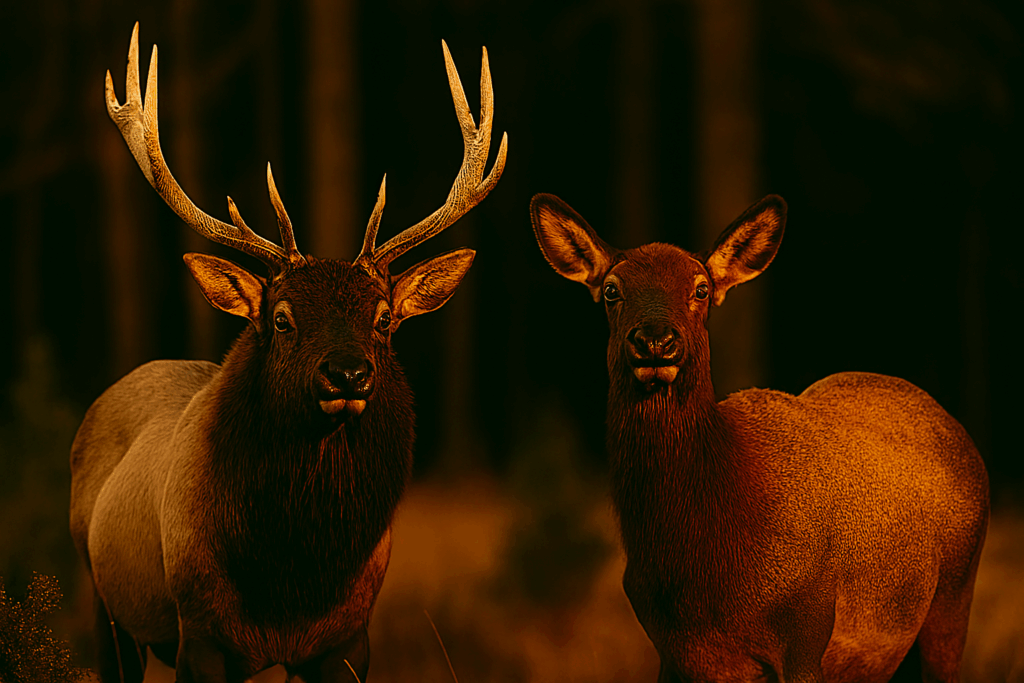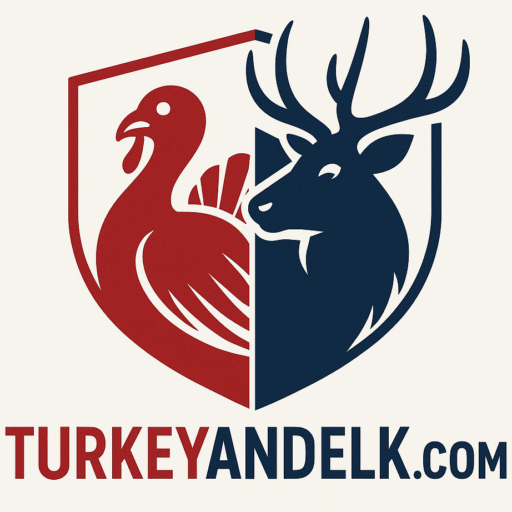Roosevelt Elk Hunting Tips
Roosevelt Elk Hunting Tips set you up for success right from the start, giving you the knowledge and tools needed to find and harvest these elusive giants of the Pacific Northwest. From understanding Roosevelt elk biology and navigating dense rainforests to mastering calling techniques and tackling unpredictable weather, this guide delivers practical strategies for hunters determined to thrive in challenging conditions. Whether you’re braving thick timber at dawn or scouting remote public land, these Roosevelt Elk Hunting Tips will help you plan, prepare, and pursue your next trophy with skill and confidence.

Biology and Physical Characteristics
Roosevelt elk are the giants of the Pacific Northwest, with bulls tipping the scales at 700 pounds or more and antlers that can span five feet from tip to tip. Cows average closer to 500 pounds, their sleek necks and smooth bodies built for moving through dense forests. These elk sport a dark brown coat in winter that lightens to a tawny hue in summer, and their rump patches glow white like beacons against shadowy timber. Unlike their Rocky Mountain cousins, Roosevelt elk have massive bodies and thicker legs to plow through brush and brambles. Their four-chambered stomachs grind moss, ferns, and woody browse into energy, fueling long days of feeding in cool, wet climates.
Their antlers aren’t just for show. Bulls wrestle each other in muddy clearings, muscles rippling under velvet as they lock racks and shove opponents off balance. These battles determine breeding rights and carve deep grooves in the forest floor. Behind those antlers sits a thick neck built to absorb shock and propel headbutts with brute force. Every muscle, every sinew of a Roosevelt bull is honed for the grunt, stomp, and crash of the rut.
Habitat and Geographic Range
Roosevelt elk roam a narrow strip from Northern California through Oregon and Washington into coastal British Columbia. Their kingdom lies in temperate rainforests, old-growth stands of Douglas fir and cedar dripping with moss, and lowland meadows that open like hidden pockets of light. Summer sees them grazing grassy clearings and riverbanks, while winter drives them to valley bottoms where snow rarely lingers. These elk thrive in areas where mountains meet the sea, twisting around fjords and estuaries for easy forage.
Dense timber and rugged coastline hide herds in plain sight. Elk travel through brush so thick it snaps your gaiters and across mud-choked bogs that swallow boots. To find them, hunt edges where trees thin and meadows begin. They’ll sneak out before dawn to graze in fog-shrouded fields, then melt back into the timber by midday. Learn the waterways, because elk follow creek bottoms and river corridors like highways through the forest.
Behavior and Hunting Challenges
Roosevelt elk live in tight-knit herds led by dominant cows, with young bulls forming bachelor groups on the outskirts. When rutting season arrives in late summer, bulls break away to assert dominance with shrill bugles that pierce the fog. Their calls bounce off cedar trunks, guiding cows through the gloom but also letting every rival know exactly where they stand.
Hunting them means surviving relentless wet and cold. You’ll crouch in a soaked-down sit, your boots squelching in mud as rain hammers your jacket. Wind whips through stands of moss-laden hemlock, carrying your scent straight to a bull’s nose. Visibility is often limited to the width of a logging road. Success hinges on timing a call perfectly while keeping every motion slow and deliberate. Lightning-quick vanishing acts mean one misstep and the herd will be gone before you can react.
Hunting Strategies and Techniques
Calling Roosevelt elk demands a soft touch and an iron will. A cow call drawn out too loud will spook wary bulls, so mimic the rhythm of real calls—short, low moans followed by hasty retreat. Use natural windbreaks like fallen logs or thickets to hide your silhouette, then pivot into the breeze to stay downwind. Scout creek crossings where elk funnel through narrow corridors, and set up early in the morning before cows start herding toward feeding areas.
Stalking works when elk bed in thick fern understory. Move inch by inch, pause to glass, then move again. Your goal is to slip within 100 yards—any further and a Roosevelt bull disappears into the green. At dusk, ambush waterholes where elk come to slurp and cool off. Sit quiet as a stump, watch your breathing, and let the elk’s curiosity do the work. They’ll edge closer, drawn to water, and you’ll slip off a shot on nature’s timeline, not yours.
Public Land Locations and Access
Public lands for Roosevelt elk include rugged National Forests like Olympic and Olympic Peninsula forests in Washington, and the Siuslaw and Tillamook in Oregon. Here, logging roads crisscross mountainsides, leading to remote meadows and alder-choked drainages. Access points are hidden behind locked gates or erased on outdated maps. You’ll bushwhack from road to ridge, cross torrents without bridges, and tackle slide paths carved by old clear-cuts.
Topographic maps and GPS tracks are your best friends. Plan helmeted scrambles over talus slopes and creek fords where elk sign glitters on muddy banks. Seasonal road closures force you to hoof in or bicycle down gravel paths. Pack enough supplies for multi-day forays; once you drop below the gate, civilization vanishes until you hike back out.
Season Information and Regulations
Roosevelt elk tag options vary by state and unit, with many areas offering limited-entry tags due to the value of these trophy bulls. Archery season often starts early, when crowds are thin and bulls are still bugling. As the calendar turns to rifle season, expect heavier pressure and more competition for the best spots. Some units enforce antler-point restrictions—only bulls with six or more points on one side may be harvested—so know your rules before you draw a bead.
Hunting hours begin a half hour before sunrise and end a half hour after sunset. Check state wildlife agency websites for any emergency closures, smoke restrictions, or special regulations. Seasons can shift with wildfire risk or habitat concerns. Stay sharp, because elk seasons don’t wait for weather delays.
Trophy Considerations and Record Keeping
Roosevelt bulls earn bragging rights for mass and palmation, where the main beam flattens into a shovel-like surface. Wide, heavy palms signal an old bull with prime genetics. Boone & Crockett scoring still matters to hardcore hunters, but local bragging rights come down to antler flair and mass. Document every step: date, exact unit, herd size, weather, and behavior. A pocket notebook glued to your hip withstands rain better than a smartphone.
Take photos with antlers against rock faces or tree trunks, and measure spread and beam length in the field. Record breakdown methods to learn packing pitfalls. Over years, compare trophy data to track herd age structure and spot rut peaks. Quality record-keeping turns your hunts into a personal dataset you can mine for future success.
Conservation and Population Status
Roosevelt elk populations grew from near collapse in the early 1900s thanks to reintroduction and habitat protections. Today, state wildlife agencies balance herd numbers against habitat capacity, logging impacts, and agricultural conflicts. Harsh winters and summer droughts still stress herds, while human development chips away at migration corridors.
Each tag fee and gear purchase funds habitat improvement and herd monitoring. Hunters are the boots on the ground, reporting herd sizes and calf survival. Embrace your role as a conservation partner: respect closures, minimize disturbance, and support habitat restoration projects. Sustainable harvest today secures elk for tomorrow’s hunters.
Tips for First-Time Hunters
Roosevelt elk hunts punish the unprepared. Waterproof everything, from packs to socks, and practice shooting in misty conditions. Glass from high points until your neck aches, then glass some more—elk will appear when you least expect it. Scout in advance and mark bedding areas and feeding flats on your GPS. Practice calls until your diaphragm reads like a bull’s lungs. Learn to quarter out an elk by feel; dark, wet nights won’t be flashlight-friendly.
Expect physical and mental challenges: waterlogged boots, slick trails, and wind-driven rain. Roll with it and adapt, because elk don’t care about your comfort. Forge your own path, learn from every failure, and sharpen skills until elk season feels like second nature rather than an ordeal.
